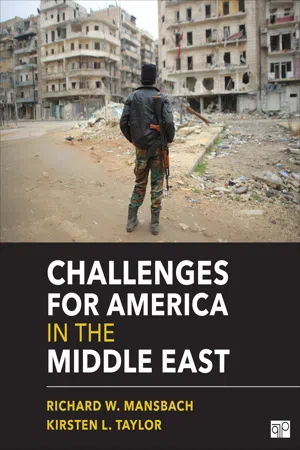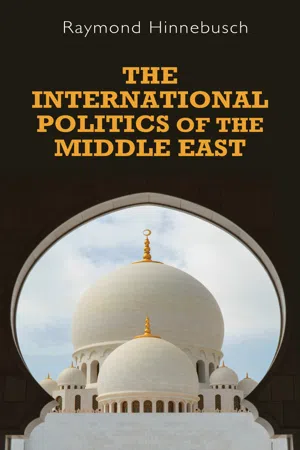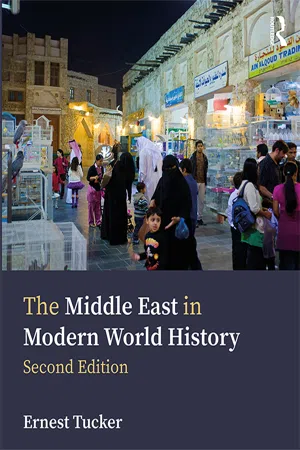America in the Middle East
"America in the Middle East" refers to the involvement and influence of the United States in the Middle Eastern region. This includes political, economic, and military interventions, as well as diplomatic efforts and foreign policy decisions. The relationship between America and the Middle East has been complex and has significantly impacted the region's history and development.
4 Key excerpts on "America in the Middle East"
- eBook - ePub
- Richard W. (Wallace) Mansbach, Kirsten L. Taylor(Authors)
- 2016(Publication Date)
- CQ Press(Publisher)
...Chapter 3 America and the Arab Middle East before the Arab Spring Our initial chapter on the Arab Spring deals with the historical background of American foreign policy toward the Arab world. It opens with an examination of the sources of U.S. foreign policy toward the Arab states. It then examines the evolution of the Arab world from the end of Ottoman Turkey’s dominance of the region in World War I. Central to this evolution was the role of oil, to which we then turn, which is followed by a discussion of U.S.–Soviet rivalry in the Middle East during the Cold War and the central role played by Egyptian president Gamal Abdel Nasser and Egypt in that competition. Egypt remains a focus in the next section, the origins of political Islam and especially the origins and evolution of the Muslim Brotherhood. The chapter concludes with a brief examination of the compatibility of political Islam and democracy. Map 3.1 The Present-Day Middle East and North Africa Sources of American Policy toward the Arab Middle East Until recently, American policy toward the Middle East has largely aimed to maintain stable and secure sources of oil and support oil-rich countries in the Persian Gulf like Saudi Arabia and Kuwait; minimize Soviet influence in the region (until the end of the Cold War); isolate and contain aggressive regional foes such as Iraq under Saddam Hussein and Iran after the overthrow of its shah; and provide security for its regional ally, Israel. In pursuing these objectives, American policy toward the Arab world has been influenced by a variety of factors and groups. External factors have been among the most prominent reasons for U.S. interest in the region. Owing to its strategic location, the Arab Middle East has been a focus of American foreign policy for decades. The region is strategically valuable for many reasons...
- eBook - ePub
Italy and the Middle East
Geopolitics, Dialogue and Power during the Cold War
- Paolo Soave, Luciano Monzali, Paolo Soave, Luciano Monzali(Authors)
- 2020(Publication Date)
- I.B. Tauris(Publisher)
...Simultaneously, the Cold War had an impact upon the positions and foreign policy strategies of the Middle East nation states, taking into account what role the superpowers could play in regard to the advancement of their own national interests. Since the end of the Second World War, issues such as the founding of the State of Israel, the question of Palestine and the continued evolution of the Arab states and Iran have been catalysts in both the former Cold War as well as the emerging ‘new’ Cold War in the contemporary Middle East. 7 The interrelationship between the historic Cold War and the Middle East region in terms of the search for peace was probably best summed up by Henry Kissinger in a speech delivered at the opening of one of the many peace conferences, held in Geneva in 1973: In all efforts for peace the overriding problem is to relate the sense of individual justice to the common good. The great tragedies of history occur not when right confronts wrong but when two rights face each other. The problems of the Middle East today have such a character. There is justice on all sides, but there is a greater justice still in finding a truth which merges all aspirations in the realization of a common humanity. It was a Jewish sage who, speaking for all mankind, expressed this problem well: ‘If I am not for myself, who is for me, but if I am for myself alone, who am I?’ 8 The United States, the Cold War and the Middle East The American relationship with the Middle East region is a long and complicated one, going as far back as the presidency of Thomas Jefferson and the issues regarding the Barbary and Tripoli wars. 9 During the Second World War era, America’s evolving relationship with the emerging Arab states 10 and the founding of the State of Israel 11 deepened its involvement in the region. For obvious geopolitical reasons, the Cold War period forced the United States into creating its own footholds spanning from the shores of the eastern Mediterranean to Iran...
- eBook - ePub
The international politics of the Middle East
Second edition
- Raymond Hinnebusch(Author)
- 2015(Publication Date)
- Manchester University Press(Publisher)
...Egypt’s Mubarak, whose government’s IMF-imposed structural adjustment was reversing the populist social contract and who portrayed his fight against political Islam as a stand on behalf of the Western world while pursing closer links with Israel, could hardly afford democratisation and reversed his previous halting steps toward it. Intense though peaceful domestic opposition to Jordan’s separate peace with Israel forced King Hussein to put Jordan’s democratisation on hold. Generally, externally driven peace agreements and economic liberalisation were obstacles to rather than facilitators of democratisation in the Middle East. The region’s ‘internationalist coalitions’, thus, remain dependent on Western support, not domestic legitimacy. At the end of the century, the liberal design showed little sign of generating a new political order in the Middle East. The failure of Pax Americana American attempts to substitute a Pax Americana for an indigenous order were also failing. To be sure, the Middle East was exceptionally impacted by the rise of US hegemony for, unlike other regions, there was no regional great power, comparable to China or India, which could balance it. The defeat of Iraq and the much-enhanced American military presence in the Gulf seemed to effectively deter any future challenges to Washington. Its manipulation of the UN Security Council sanctions against Iraq demonstrated its ability to punish recalcitrant actors as never before. The US sponsorship of the Arab–Israeli peace process also made it pivotal to the interests of all regional actors, including Arab nationalist Syria, and fostered a potential Israeli regional hegemony working in concert with Washington. US influence was also exercised indirectly through the other most powerful states in the region – Egypt, Turkey and Saudi Arabia...
- eBook - ePub
- Ernest Tucker(Author)
- 2019(Publication Date)
- Routledge(Publisher)
...Although many nations in the region had legislatures, most had little power, or were chosen by electorates whose right to vote was constrained by religious and/or ethnic identity as well as citizenship, making political participation a rarity. Analysts have observed how the negative impacts of political repression, economic corruption and social cronyism, overspending on arms and projects to aggrandize rulers, combined with depending too much on oil revenues, have all inhibited the growth of strong nations with healthy economies in the Middle East. Many commentators from the region have also pointed to the negative effects of outside Western interference in the region. They blame many, if not most, of the region’s problems on outsiders. Foreign commentators, following the approach of Edward Said, have echoed this. They point to the West’s creation, starting in the late eighteenth century, of an imaginary “Orient” that the West exploited to control the Middle East on its own terms. The debate about what caused the Middle East’s lack of advancement and progress in recent history can continue endlessly. The only certain thing, though, is that the region will remain, even if only by virtue of its geographical situation, at the center of global affairs. It has been, is, and will continue to be a world crossroads, with all that is good and bad about that. This was suddenly demonstrated again by the precipitous events unfolding in the region during the first months of 2011 in what has been called the “Arab Spring.” This began in December 2010, when Mohamed Bouazizi, a 26-year-old fruit vendor in a small town in Tunisia, set himself on fire to protest government corruption...



